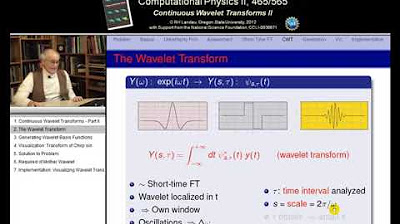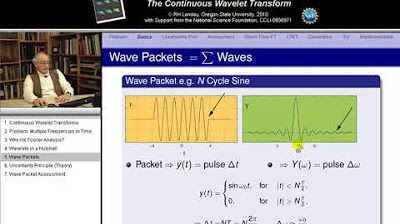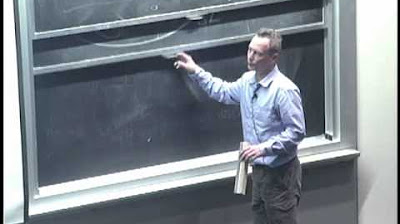1. Signals and Systems
TLDRThe transcript outlines an MIT OpenCourseWare lecture on signals and systems, emphasizing the importance of practice in mastering subjects. It introduces the 6.003 abstraction, where systems are viewed as having inputs and outputs, and explores the concept of signals as mathematical functions. The lecture distinguishes between continuous-time (CT) and discrete-time (DT) signals and discusses the conversion between them, crucial for digital processing. Interactive examples involving sound and image processing illustrate the principles, highlighting the power of this abstraction for various applications.
Takeaways
- 📚 The course focuses on systems and signals, emphasizing the importance of practice and homework in mastering the subject.
- 🎓 Two types of homework will be assigned: conventional problems with clear answers and engineering design problems that are more open-ended and challenging.
- 🤖 A tutor-type environment has been developed for 6.003 to assist with checking the answers for conventional problems.
- 📅 Homework assignments will be due on Wednesdays, with one grace period allowed for late submissions.
- 📝 Collaboration is encouraged in the course, but students must write their own work and acknowledge any significant help received.
- 🚀 The course material may not follow the order in the recommended textbook, but a week-by-week breakdown is provided on the website.
- 🥊 Three midterm exams and a final exam will be administered, with the exams having increasing weight as the course progresses.
- 🔄 The course will cover the concept of input-output abstraction, where systems are viewed in terms of their inputs and outputs.
- 🧠 The abstraction method helps to focus on the aspects of interest and suppress less relevant details.
- 🔄 The course will also cover the conversion between continuous-time (CT) and discrete-time (DT) signals, which is crucial for digital signal processing.
- 🎧 An interactive exercise involving computer-generated speech sounds was conducted to illustrate signal transformations and their mathematical representations.
Q & A
What is the primary focus of the 6.003 course?
-The primary focus of the 6.003 course is the study of systems and signals, particularly the abstraction of representing a system by how it transforms an input into an output.
What are the two types of homework problems given in the course?
-The two types of homework problems are conventional problems with simple, unambiguous, easily checkable answers, and engineering design problems which are more ambitious, fun, and harder, often requiring numerics and plotting to make an argument.
How does the tutor environment help students with conventional problems?
-The tutor environment allows students to check their answers to simple, well-defined problems by submitting them and receiving immediate feedback on whether they got the right answer, similar to the environment used in course 6.01.
What is the purpose of the open or block office hours?
-The open or block office hours are designed to provide a space for students to work on their engineering design problems, where they can easily get help from peers and staff members, making it easier to address any uncertainties or questions they may have.
What is the collaboration policy for the course?
-The collaboration policy encourages students to discuss and help each other understand the concepts. However, when it comes to writing up and submitting homework, students are expected to present their own work, acknowledging any significant conceptual help received from others.
How does the course handle deadlines and late submissions?
-The course has firm deadlines with all homeworks due on Wednesdays. Students can submit one late without penalty, but a second late submission could affect their grade unless excused by a dean, instructor, or medical personnel, in which case it would count as half its normal value.
What is the recommended textbook for the course, and how does the course order differ from it?
-The recommended textbook is by Oppenheim and Willsky, but the order of coverage in the course may not precisely follow the textbook's order. The instructor has rearranged some subjects to start with easier points, making it easier to progress to more difficult material.
How many and what type of exams will there be in the course?
-There will be three midterm exams and a final exam. The midterms are evening exams on Wednesdays and are designed to have a gentle ramp in terms of their contribution to the final grade, with the first exam worth 10%, the second 15%, the third 20%, and the final exam worth 40%.
What is the concept of signals in the context of the course?
-In the context of the course, signals are mathematical functions that can represent various physical quantities and are generally functions of time. They can have multiple dimensions and can be represented in both continuous time (CT) and discrete time (DT).
How does the signals and systems approach simplify the analysis of complex systems?
-The signals and systems approach simplifies the analysis of complex systems by abstracting away unnecessary details and focusing on the input-output relationship. This allows for the easy combination of components characterized by their input-output behavior, regardless of the underlying substrate.
What is the significance of converting between continuous time and discrete time representations in the course?
-Converting between continuous time and discrete time representations is significant because it allows engineers to process signals computationally in the digital domain, which is often easier and more efficient. The course will cover how to represent a signal that naturally lives in the physical world in a discrete form for processing and how to reconstruct it back to a continuous form for practical applications.
Outlines
📚 Introduction to 6.003 and Homework
The paragraph introduces the 6.003 course, emphasizing the importance of practicing through homework. It outlines two types of homework: conventional problems with clear answers and engineering design problems that are more complex and open-ended. The use of programming languages is discussed, with Python being the assumed language due to prerequisites of 6.01 and 6.02. The paragraph also introduces a new tutor-type environment for 6.003 to assist with conventional problems and extended office hours for help with engineering design problems. The importance of collaboration and individual work is stressed, along with the consequences of late submissions and the structure of exams.
🤝 Collaboration Policy and Deadlines
This paragraph discusses the collaboration policy for the course, encouraging students to discuss and help each other understand concepts but requiring them to write their own homework solutions. The policy asks for acknowledgment of significant conceptual help from others. It also explains the homework submission process, including one free late slip and penalties for further late submissions. The paragraph outlines the exam schedule, with three midterms and a final, each carrying different weights to allow for a gentle learning curve.
🗣️ Feedback and Course Structure
The speaker asks for student volunteers to provide feedback on the course, aiming to understand the class's perspective and improve teaching methods. This opportunity is open to those interested in teaching as a career and is entirely voluntary with no impact on grades. The paragraph also explains that the course order of coverage differs from the recommended textbook to facilitate easier understanding of the material. The course focuses on the abstraction of systems with one input and one output, which is a powerful and versatile concept applicable to various types of systems.
🔄 Input-Output Abstraction and Examples
This section delves into the course's central concept of representing systems as transformations from input to output. It provides examples of physical systems like mass-spring systems and leaky tanks, and abstracts them into input-output relationships. The paragraph also discusses the versatility of this approach, highlighting its wide applicability across different disciplines and the ability to focus on specific aspects of a system by choosing appropriate inputs and outputs.
📱 Cell Phone Systems and Abstraction
The paragraph uses the cell phone system to illustrate the power of the input-output abstraction. It explains how the complex process of sound input and output can be simplified by focusing on the flow of information. The speaker emphasizes the combinational nature of these systems, similar to how Python functions can be combined in 6.01. This abstraction allows for easy analysis and combination of components, regardless of the underlying technology or substrate.
📊 Signals: Functions and Dimensions
The speaker defines signals as mathematical functions, often of time, but not limited to it. Signals can have multiple dimensions, such as the 4D videos of ear cells responding to sound in the speaker's research. The paragraph introduces the concepts of continuous-time (CT) and discrete-time (DT) signals, highlighting the importance of converting between these two representations for computational processing and practical applications like MP3 and JPEG formats.
🔄 Reconstruction and Interpolation
This section discusses the process of reconstructing continuous signals from their discrete representations and vice versa. It introduces the zero-order hold method commonly used in MP3s and the linear interpolation used in image processing. The speaker explains that different interpolation methods are chosen based on the perceptual differences between auditory and visual systems.
🎧 Sound Transformations and Signal Analysis
The speaker engages the class in an interactive exercise where they listen to computer-generated speech sounds and determine the mathematical transformations applied to the original signal. The exercise aims to help students understand the effects of time scaling and amplitude inversion on signals. The discussion also touches on the challenge of changing the speed of a signal without affecting its pitch, which is a complex problem in signal processing.
🖼️ Image Processing and Mapping
The paragraph presents an image processing exercise where students analyze transformations of an image of a building. The speaker introduces the concept of mapping to determine if the mathematical representations of the transformations are correct. By checking specific points and their corresponding locations in the transformed image, students can deduce the accuracy of the transformations. The exercise reinforces the idea of using signals and systems to analyze and manipulate different types of data.
🔜 Course Preview and Final Thoughts
In the concluding paragraph, the speaker previews the next class, which will focus on simple systems and their analysis using similar thinking to what was applied to signals. The speaker encourages students to have a good weekend, indicating a break before continuing with the course material.
Mindmap
Keywords
💡Creative Commons license
💡MIT OpenCourseWare
💡Engineering design problems
💡Collaboration policy
💡Numerical solutions
💡Programming language
💡Tutor-type environment
💡Office hours
💡Homework policy
💡Exam structure
💡Feedback mechanism
Highlights
The concept of learning through practice is emphasized, comparing it to various fields such as music, sports, and academics.
Two types of homework are assigned: conventional problems with clear answers and engineering design problems that are more open-ended and ambitious.
The importance of working on homework for mastering the subject is highlighted, rejecting the passive learning theory.
The use of numerical methods and plotting in engineering design problems to support and communicate solutions is discussed.
Students are encouraged to use any programming language they prefer, with Python being the default due to prerequisites.
A new tutor-type environment was developed for 6.003 to assist with conventional problems.
Extended office hours, referred to as open or block office hours, are provided to help students with engineering design problems.
Collaboration policy is explained, emphasizing individual work and proper acknowledgment of help received.
Homework deadlines are strict, with one grace period allowed, but repeated late submissions can affect the grade.
The course structure is designed to start with easier topics before progressing to more difficult material.
The course covers the same material as Oppenheim and Willsky's textbook, but in a different order for better understanding.
Exams are structured to gradually count for more of the final grade, allowing for a gentle learning curve.
Feedback from students is actively sought to improve the course, with a volunteer group meeting weekly to discuss concerns.
The course focuses on the 6.003 abstraction, which involves thinking of systems as having one input and one output.
The versatility of the input-output abstraction is emphasized, as it can be applied to a wide range of systems and disciplines.
The concept of combinational systems is introduced, where the focus is on how components can be combined based on their input-output behavior.
Transcripts
5.0 / 5 (0 votes)
Thanks for rating:





